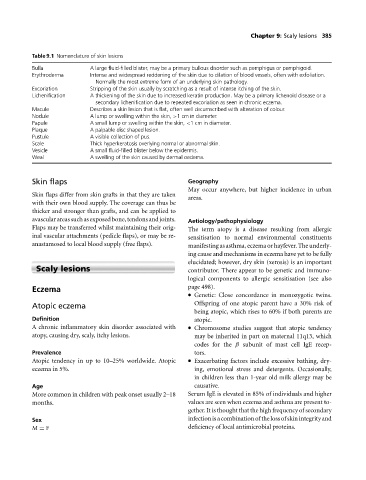Page 389 - Medicine and Surgery
P. 389
P1: FAW
BLUK007-09 BLUK007-Kendall May 12, 2005 19:59 Char Count= 0
Chapter 9: Scaly lesions 385
Table 9.1 Nomenclature of skin lesions
Bulla A large fluid-filled blister, may be a primary bullous disorder such as pemphigus or pemphigoid.
Erythroderma Intense and widespread reddening of the skin due to dilation of blood vessels, often with exfoliation.
Normally the most extreme form of an underlying skin pathology.
Excoriation Stripping of the skin usually by scratching as a result of intense itching of the skin.
Lichenification A thickening of the skin due to increased keratin production. May be a primary lichenoid disease or a
secondary lichenification due to repeated excoriation as seen in chronic eczema.
Macule Describes a skin lesion that is flat, often well circumscribed with alteration of colour.
Nodule A lump or swelling within the skin, >1cmin diameter.
Papule A small lump or swelling within the skin, <1cmin diameter.
Plaque A palpable disc shaped lesion.
Pustule A visible collection of pus.
Scale Thick hyperkeratosis overlying normal or abnormal skin.
Vesicle A small fluid-filled blister below the epidermis.
Weal A swelling of the skin caused by dermal oedema.
Skin flaps Geography
Mayoccur anywhere, but higher incidence in urban
Skin flaps differ from skin grafts in that they are taken
areas.
with their own blood supply. The coverage can thus be
thicker and stronger than grafts, and can be applied to
avascularareassuchasexposedbone,tendonsandjoints. Aetiology/pathophysiology
Flaps may be transferred whilst maintaining their orig- The term atopy is a disease resulting from allergic
inal vascular attachments (pedicle flaps), or may be re- sensitisation to normal environmental constituents
anastamosed to local blood supply (free flaps). manifesting as asthma, eczema or hayfever. The underly-
ing cause and mechanisms in eczema have yet to be fully
elucidated; however, dry skin (xerosis) is an important
Scaly lesions contributor. There appear to be genetic and immuno-
logical components to allergic sensitisation (see also
Eczema page 498).
Genetic: Close concordance in monozygotic twins.
Atopic eczema Offspring of one atopic parent have a 30% risk of
being atopic, which rises to 60% if both parents are
Definition atopic.
Achronic inflammatory skin disorder associated with Chromosome studies suggest that atopic tendency
atopy, causing dry, scaly, itchy lesions. may be inherited in part on maternal 11q13, which
codes for the β subunit of mast cell IgE recep-
Prevalence tors.
Atopic tendency in up to 10–25% worldwide. Atopic Exacerbating factors include excessive bathing, dry-
eczema in 5%. ing, emotional stress and detergents. Occasionally,
in children less than 1-year old milk allergy may be
Age causative.
More common in children with peak onset usually 2–18 Serum IgE is elevated in 85% of individuals and higher
months. values are seen when eczema and asthma are present to-
gether. It is thought that the high frequency of secondary
Sex infectionisacombinationofthelossofskinintegrityand
M = F deficiency of local antimicrobial proteins.

